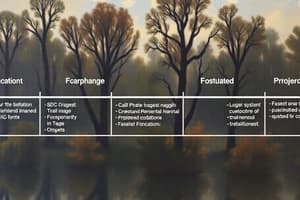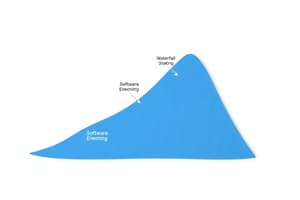Podcast
Questions and Answers
In which phase of the Systems Development Life Cycle (SDLC) are the needs for a new system or improvements to an existing one identified?
In which phase of the Systems Development Life Cycle (SDLC) are the needs for a new system or improvements to an existing one identified?
- Planning (correct)
- System Design
- System Analysis
- Testing
During which SDLC phase are business requirements gathered and analyzed?
During which SDLC phase are business requirements gathered and analyzed?
- System Analysis (correct)
- System Design
- System Implementation
- Maintenance
Which output is typically produced during the system design phase of the SDLC?
Which output is typically produced during the system design phase of the SDLC?
- Test Cases
- Program Code
- Bug Fixes
- System Prototype (correct)
In the SDLC, what is the primary focus of the development/implementation phase?
In the SDLC, what is the primary focus of the development/implementation phase?
What is the primary objective of the testing phase in the SDLC?
What is the primary objective of the testing phase in the SDLC?
Which of the following testing types involves evaluating individual software modules?
Which of the following testing types involves evaluating individual software modules?
What activity is associated with the 'Deployment' phase of the SDLC?
What activity is associated with the 'Deployment' phase of the SDLC?
Which of the following activities is typically performed during the maintenance phase of the SDLC?
Which of the following activities is typically performed during the maintenance phase of the SDLC?
What is a key characteristic of the Waterfall model in SDLC?
What is a key characteristic of the Waterfall model in SDLC?
In which scenario is the Waterfall model best suited?
In which scenario is the Waterfall model best suited?
Which of the following is a key characteristic of the Agile model in software development?
Which of the following is a key characteristic of the Agile model in software development?
In Agile methodologies, what does 'adaptive planning' primarily focus on?
In Agile methodologies, what does 'adaptive planning' primarily focus on?
Which of the following is a key principle of Rapid Application Development (RAD)?
Which of the following is a key principle of Rapid Application Development (RAD)?
What is the primary goal of using prototypes in the RAD model?
What is the primary goal of using prototypes in the RAD model?
Which type of projects are best suited for the RAD model?
Which type of projects are best suited for the RAD model?
What is a key characteristic of the Spiral model in software development?
What is a key characteristic of the Spiral model in software development?
Which phase is unique to the V-Model compared to the Waterfall model?
Which phase is unique to the V-Model compared to the Waterfall model?
Which of these is a disadvantage of the Waterfall model?
Which of these is a disadvantage of the Waterfall model?
Which type of Documentation level is a disadvantage of the Agile method?
Which type of Documentation level is a disadvantage of the Agile method?
Which SDLC model is most dependent on customer collaboration?
Which SDLC model is most dependent on customer collaboration?
Flashcards
SDLC (System Development Life Cycle)
SDLC (System Development Life Cycle)
A structured process used by organizations to design, develop, test, and deploy information systems or software applications.
Planning Phase
Planning Phase
A phase of SDLC that identifies the needs for a new system or improvements to an existing one, resulting in a project plan.
System Analysis
System Analysis
A phase of SDLC where the project scope, objectives, and timeline are defined.
System Design
System Design
Signup and view all the flashcards
Development (Implementation)
Development (Implementation)
Signup and view all the flashcards
Testing
Testing
Signup and view all the flashcards
Deployment
Deployment
Signup and view all the flashcards
Maintenance
Maintenance
Signup and view all the flashcards
Agile Model
Agile Model
Signup and view all the flashcards
Agile Phases (CDTRM)
Agile Phases (CDTRM)
Signup and view all the flashcards
RAD(Rapid Application Development)
RAD(Rapid Application Development)
Signup and view all the flashcards
RAD - Requirement Planning & User Design
RAD - Requirement Planning & User Design
Signup and view all the flashcards
RAD - Cutover
RAD - Cutover
Signup and view all the flashcards
V-Model
V-Model
Signup and view all the flashcards
Study Notes
- System Development Life Cycle (SDLC) is a structured process used by organizations to design, develop, test, and deploy information systems or software applications.
Phases of SDLC (PSDTDM)
- Planning identifies the needs for a new system or improvements to an existing one.
- Output of planning includes a feasibility report and a project plan.
- System Analysis gathers and analyzes business requirements, defining the system functionalities.
- It involves creating a Data Flow Diagram (DFD) and an Entity Relationship Diagram (ERD).
- Output of system analysis includes a requirement specification document and system models.
- System Design converts requirements into a detailed design.
- It defines the structure/architecture of the system, database, user interface aspects, and security measures.
- It involves specifying hardware and software requirements.
- Output of system design includes a system design, a prototype (capstone), and UI/UX design.
- Development (Implementation) involves developers writing and compiling code based on the design, using programming languages like Java, VB, C#, or Python.
- Output of development is program code or software modules.
- Testing evaluates the system to ensure it functions as expected.
- Types of testing include unit testing (per module), integration testing (integrating modules), system testing (whole system), and user acceptance testing.
- Output of testing are test cases, reports, and bug fixes.
- Deployment is when the system is released for actual use.
- Deployment strategies include direct cutover, parallel, or phased (pilot/routine deployment).
- Output includes the live system, training manuals, and user support.
- Maintenance provides ongoing support, bug fixes, and enhancements.
- Maintenance involves system updates, maintenance reports, and user feedback.
Importance of SDLC
- SDLC provides a structured approach.
- It aids in risk management and cost control.
- It ensures software quality and user satisfaction.
- It promotes efficiency and collaboration.
SDLC Models
- Waterfall Model is a sequential or phase-by-phase approach.
- Agile Model
- Spiral Model
- V-Model focuses on validation and verification
- RAD (Rapid Application Development)
Waterfall Model
- Waterfall model is a sequential or phase-by-phase approach.
- Considered one of the earliest and most structured models of the SDLC.
- Introduced by Winston W. Royce in 1970.
- Phases include requirements gathering & analysis, system design, implementation/development, testing, deployment, and maintenance.
Advantages of Waterfall
- Structured and simple to follow.
- Well-documented.
- Easier to manage.
- Best for small & stable projects.
Disadvantages of Waterfall
- Rigid and inflexible.
- Late testing and feedback.
- Not ideal for complex projects.
- Minimal user involvement.
- Use waterfall for projects with well-defined requirements.
- Suitable for small to medium-sized projects.
- Use for projects with minimal expected changes.
- Good for government or regulatory projects.
Agile Model
- Agile is a kind of integrative and flexible and continuous feedback.
- Modern alternative and flexible approach to software development that focuses on continuous improvement, collaboration, and customer feedback.
- Employs adaptive planning.
- Phases of concept and planning, design, development, testing, release/deployment, feedback, maintenance & review.
- Iterations usually taken 1 to 4 weeks
- Key developers were Kent Beck, Mike Beedle, Arie van Bennekum, Alistair Cockburn, Ward Cunningham, and Martin Fowler
When to use Agile
- If projects have evolving requirements
- Start up and business market adaption
- Continues user and customer feedback is required
- Teams that prioritize flexibility and collaboration
RAD (Rapid Application Development) Model
- Relies on rapid prototype and is faster because of the concurrent model.
- Iterative and adaptive software development methodology that emphasizes quick prototyping & user feedback and fast delivery.
- Introduced in the 1980's by James Martin as an alternative to Waterfall model.
- Phases include requirement planning (capturing initial requirements), user design (developers need to create prototype), rapid construction, and cutover (training, support and maintenance provided).
Characteristics of RAD
- Fast development.
- User involvement.
- Iterative process.
- Minimal documentation.
Advantages of RAD
- Fast delivery
- User Centric
- Flexible
- High Quality Output
Disadvantages of RAD
- Requires skilled Team
- Not suitable for large complex systems
- High user involvement needed
- Difficult to manage large teams
When to use the RAD model
- Projects with fast changing Requirements
- Small to medium sized applications
- Projects where user feedback is critical
- When reusable components or low code tools can be leveraged.
Spiral Model
- Big Project
V Model
- Validation and verification
- Tests occur at all development phases
Studying That Suits You
Use AI to generate personalized quizzes and flashcards to suit your learning preferences.




